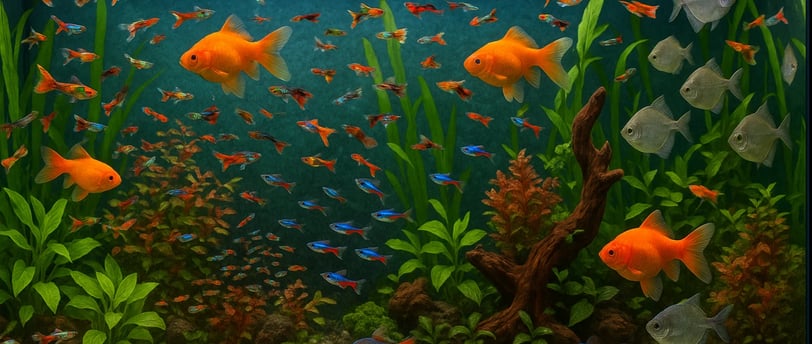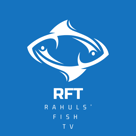Pet fish are often seen as low-maintenance companions, and while they may not need walks or grooming, they still require proper care and attention. Creating and maintaining a healthy environment for your fish is crucial to their well-being and longevity. Whether you're a first-time fish owner or looking to improve your aquarium care, this comprehensive guide will walk you through the essential steps of taking care of pet fish.
Choosing the Right Fish
Before diving into tank setups and water chemistry, it’s important to choose the right fish. Consider:
Freshwater vs. Saltwater: Freshwater fishlike goldfish, bettas, guppies, and tetras are great for beginners. Saltwater fish, such as clownfish or tangs, require more precise care and are best for experienced aquarists.
Compatibility: Not all fish get along. Research which species can live together peacefully. Avoid mixing aggressive and timid fish.
Tank Size Needs: Some fish, like goldfish, grow larger than people expect and need more space than a small bowl can provide.
Choose fish that match your experience level, lifestyle, and the amount of time you can commit to care and maintenance.
Setting Up the Aquarium
Your fish tank isn’t just a container—it’s a miniature ecosystem. Here’s how to set it up correctly:
1. Pick the Right Tank Size
Bigger is often better. A larger tank is more stable in terms of water quality and temperature, making it easier to maintain. As a rule of thumb, allow one gallon of water per inch of fish—but remember, this varies by species.
2. Add Substrate and Decorations
Gravel or sand acts as a base layer for plants and decor. Wash it thoroughly before placing it in the tank. Add rocks, plants, and ornaments to provide hiding spots and make your tank visually appealing. Be sure decorations are fish-safe and free of sharp edges.
3. Install a Filter and Heater
Filter: Essential for removing waste and keeping water clean. Choose a filter suitable for your tank size.
Heater: Many tropical fish require stable warm temperatures. Install a heater and monitor with a thermometer.
4. Cycle the Tank
Don’t add fish right away. “Cycling” the tank means establishing beneficial bacteria that break down fish waste. This process takes 4–6 weeks. You can speed it up with bottled bacteria supplements. Test water regularly for ammonia, nitrites, and nitrates during this phase.
Introducing Your Fish
Once the tank is fully cycled and parameters are stable, it’s time to add your fish.
Acclimate Slowly: Don’t dump fish straight from the bag into the tank. Float the sealed bag in the tank for 15–20 minutes to match temperatures. Slowly add small amounts of tank water into the bag over the next hour before gently releasing the fish.
Start Small: Add only a few fish at a time to avoid overwhelming the tank’s biological filter.
Feeding Your Fish
Feeding is more than just dropping flakes into the water. Here’s how to feed properly:
Feed the Right Food: Different species require different diets—flakes, pellets, live or frozen food, algae wafers, etc. Do your research based on the fish species.
Stick to a Schedule: Feed small amounts once or twice daily. Only give what your fish can eat in 2–3 minutes to avoid overfeeding and water pollution.
Remove Leftovers: Uneaten food decays and affects water quality. Scoop it out with a net after feeding time.
Maintaining Water Quality
Clean water is key to fish health. Poor water conditions can stress fish and lead to disease.
Weekly Maintenance Checklist:
Test the Water: Check for ammonia, nitrites, nitrates, and pH using a water test kit.
Do a Partial Water Change: Replace 10–25% of the water weekly with clean, dechlorinated water.
Vacuum the Gravel: Use a gravel siphon to remove debris and waste.
Clean the Filter: Rinse filter media in tank water (not tap water!) to preserve beneficial bacteria. Replace parts as directed, but not all at once.
Monitoring Fish Health
Healthy fish are active, alert, and colorful. Keep an eye out for signs of illness:
Clamped fins
Erratic swimming or floating
Loss of appetite
White spots (possible ich)
Discoloration or fuzzy growth
If you notice anything unusual, test your water first—many problems are caused by water quality issues. Quarantine sick fish if possible and consult an expert or veterinarian for treatment options.
Dealing with Algae
Some algae in your tank are natural and even beneficial, but too much can be a sign of imbalance.
To control algae:
Don’t overfeed (excess nutrients fuel algae).
Limit tank lighting to 8–10 hours a day.
Add algae-eaters like snails, shrimp, or certain fish.
Clean tank glass regularly using a safe algae scraper.
Enriching Your Fish’s Environment
Fish can get bored too! Enrichment helps reduce stress and mimics natural behaviors:
Rearrange decorations periodically.
Introduce live plants—they provide shelter, oxygen, and a more natural environment.
Vary their diet with occasional treats like frozen bloodworms.
Use gentle water flow or bubble wands to simulate natural currents.
Common Mistakes to Avoid
Skipping the nitrogen cycle: Adding fish to an uncycled tank leads to deadly ammonia spikes.
Overcrowding: Too many fish in a small tank can cause stress, illness, and aggression.
Inconsistent water changes: Neglecting regular maintenance causes deteriorating conditions.
Mixing incompatible species: Always research fish temperament and needs before adding new tankmates.
Final Thoughts
Taking care of pet fish is a rewarding hobby that combines science, design, and compassion. With the right knowledge and commitment, you can create a thriving aquatic world where your fish live happily and healthily.
Remember: a successful aquarium doesn’t happen overnight. It takes time, patience, and consistency. But the beauty and calm that a well-maintained tank brings to your home—and the satisfaction of caring for living creatures—are absolutely worth the effort.
Ready to dive in? Start small, stay curious, and enjoy the peaceful world of fishkeeping. 🐠🌿💧




